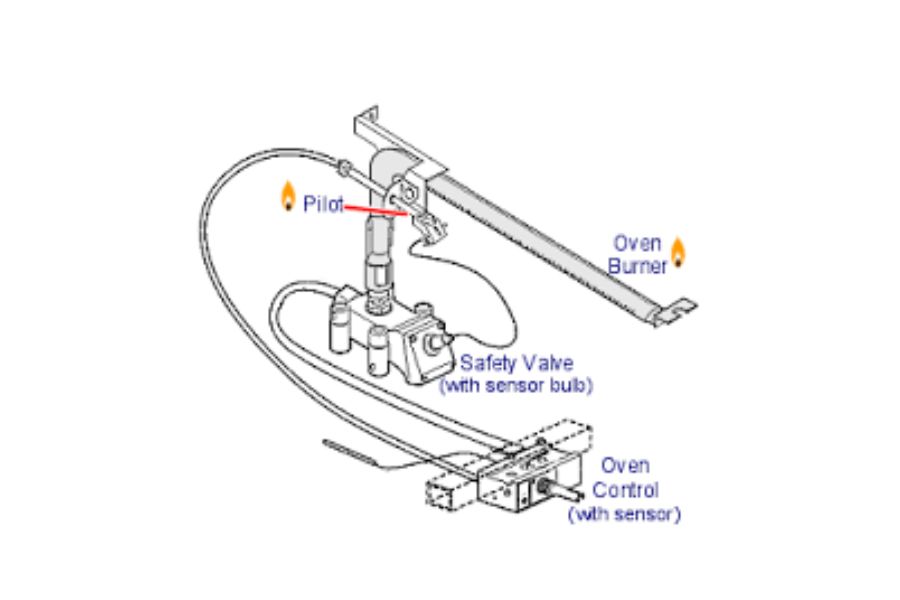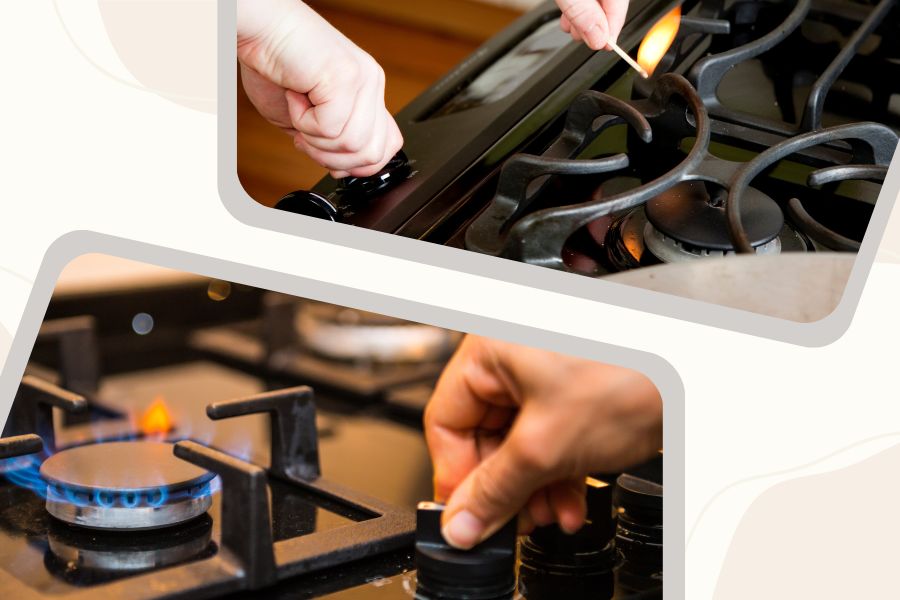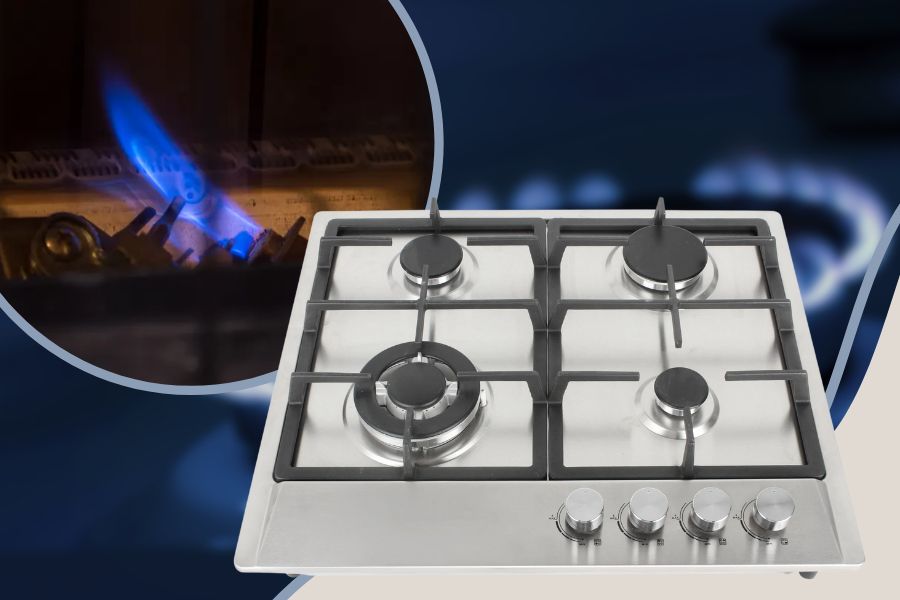The gas stove is a crucial tool in my kitchen, known for its precise heat control when cooking up a storm. But here’s the kicker: the ever-burning pilot light. Yes, that small flame under the burner or at the bottom of the oven is always ready to ignite the gas and start the cooking. Sounds convenient, right? Well, it’s not all sunshine and rainbows.
Although pilot lights have long been a staple in traditional gas stoves, they can be a thorn in your side. They’re not exactly energy-efficient and, let’s face it, having an open flame burning continuously can be a safety concern.
So, do all gas stoves have pilot lights? Whether you’re a seasoned chef or someone new to the culinary game, understanding the ignition system of your gas range can help you make an informed decision for your kitchen. This article will explore pilot lights, their pros and cons, and modern alternatives like electric ignition systems.
What is a Pilot Light, and How Does it Work?

A pilot light is a small flame that burns continuously on a gas stove, even when the burners are not used. It is an ignition source for the gas burners, allowing them to be easily and quickly lit when needed. The purpose of the pilot light is to ensure that the gas burner is always ready for use, without the need for manual ignition each time.
To light a pilot light on a gas stove, you typically need to turn the gas valve to the “pilot” setting and hold down the knob or button that controls the gas flow to the pilot light. While holding the knob or button down, use a match or lighter to light the pilot light. Once the pilot light is lit, hold the knob or button down for a few seconds to allow the pilot light to heat the thermocouple, a safety device that detects the presence of a flame.
Keeping a pilot light clean and free of debris is important, which can interfere with its ability to burn properly. You should also regularly check the pilot light to ensure that it is still burning. This is because a pilot light that has gone out can be a safety hazard.
In addition, it is important to periodically inspect the thermocouple and replace it if it is damaged or not functioning properly. Proper pilot light maintenance is crucial for a gas stove’s safe and efficient operation.
Types of Gas Stoves With Pilot Lights
Two main types of gas stoves use pilot lights:
Traditional Models
Traditional gas stoves with pilot lights have been around for many years and are characterized by their simple design and reliable operation. These stoves typically have a standing pilot light that is always on, and the burners are lit manually by turning a knob and using a match or lighter.
Traditional gas stoves are typically less expensive than modern models and can be easier to maintain since they have fewer components that can malfunction.
Modern Models
On the other hand, modern gas stoves with pilot lights are more efficient and environmentally friendly. These stoves use an electronic ignition system to light the pilot and burners, eliminating the need for a standing pilot light. This system creates a spark to ignite the gas when the stove is turned on.
Modern gas stoves are also equipped with safety features that automatically shut off the gas if the flame is extinguished, which reduces the risk of gas leaks and fires.
The main difference between traditional and modern gas stoves with pilot lights is the method of ignition and the presence of a standing pilot light. While traditional stoves have a standing pilot light that burns continuously, modern stoves use electronic ignition to ignite the gas when the stove is turned on.
This means that modern stoves do not require manual lighting with a match or lighter. As a result, they are generally more efficient and safer to use.
However, modern stoves can be more complex and expensive to maintain since they have electronic components that can malfunction and require specialized knowledge to repair.

| Traditional Gas Stoves | Modern Gas Stoves | |
| Method of Ignition | Manual lighting with a match or lighter | Electronic ignition system |
| Presence of Pilot Light | Standing pilot light that burns continuously | No standing pilot light |
| Efficiency | Less efficient, since the standing pilot light uses gas constantly | More efficient, since the electronic ignition system only uses gas when the stove is turned on |
| Maintenance | Easier to maintain, with fewer components that can malfunction | More complex and expensive to maintain, with electronic components that require specialized knowledge to repair |
| Safety | Lower safety features, since the standing pilot light can be a fire hazard if not maintained properly | Higher safety features, with automatic shut-off if the flame is extinguished, reducing the risk of gas leaks and fires |
| Cost | Less expensive than modern models | More expensive than the traditional models |
Pros and Cons of Gas Stoves with Pilot Lights
When choosing a gas stove, one crucial feature is whether the stove has a pilot light. Understanding the pros and cons of having a gas stove with a pilot light can help you make an informed decision that suits your cooking needs and lifestyle.
Benefits of Gas Stoves with Pilot Lights
Improved Safety
One significant advantage of a pilot light on a gas stove is improved safety. The pilot light provides a constant small flame, ensuring easy and quick ignition of the gas burners. This reduces the risk of gas buildup, which could otherwise lead to dangerous explosions.
Consistent Heat Output
With a pilot light, your gas stove is always ready for action. The consistent small flame ensures that your stove can quickly achieve the desired heat output, easily controlled by turning the knob.
Reliability
Traditional gas stoves with pilot lights have a long history of reliability. These stoves are often less complex than modern gas stoves with electric ignition systems. This makes them easier to operate and maintain.
Cons of Gas Stoves with Pilot Lights
Regular Maintenance
A standing pilot light necessitates regular maintenance to keep it functioning correctly. Suppose the pilot light area accumulates debris or the thermocouple — a safety device that detects the flame — is not working properly. In that case, the pilot light may go out, requiring re-ignition and possible professional assistance.
Energy Inefficiency
While the pilot light ensures the stove is always ready to ignite, it also consumes gas continuously, even when the stove and oven are not in use. This constant gas flow can significantly contribute to energy inefficiency, increasing utility bills.
Traditional gas stoves may have a nostalgic or aesthetic appeal. However, they may not be as energy-efficient as newer gas stoves with electric ignition systems.
Risk of Gas Leaks
If the pilot light isn’t properly maintained, it can become a source of gas leaks. A gas leak is not just wasteful; it’s also a safety hazard. Leaking gas can accumulate and, if ignited, lead to fires or even explosions.
Therefore, it’s crucial to regularly inspect the gas line and valve connected to the pilot light to ensure they’re in good working condition.
Alternative Ignition Systems for Gas Stoves
Regarding gas stoves, today’s gas appliances offer more than just the traditional standing pilot lights for ignition. Let’s explore some alternative systems.
Electronic Ignition
Electronic ignition systems are often found in modern gas stoves and gas cooktops. They use an electronic spark or glow bar to ignite the gas burners when users turn the control knob. The advantages of electronic ignition systems include:
- Energy Efficiency: Unlike a standing pilot light that’s always burning, electronic ignition systems only use gas when needed, enhancing energy efficiency and reducing utility bills.
- Safety: These systems are engineered to shut off the gas flow if the flame goes out, mitigating the risk of gas leaks or potential fires.
- Convenience: Forget about lighting with a match or lighter. Electronic ignition offers hassle-free operation.
However, electronic ignition systems aren’t without drawbacks:
- Cost: Initially, electronic ignition systems can be more expensive to install. Repairs, when needed, can also be costlier due to their complexity.
- Complexity: With more components like electric ignitors and circuits, these systems can be more challenging to repair and maintain than traditional stoves with pilot lights.
Standing Pilot Lights
Standing pilot lights serve as the conventional ignition system and employ a small flame to sustain the gas flow to the burner. Their pros and cons mirror those of modern gas stoves but from an opposite angle:
- Reliability: Standing pilot lights have a legacy of consistent performance and straightforward upkeep.
- Lower Cost: These are usually less expensive to install and maintain than their electronic counterparts.
However, the drawbacks are significant:
- Energy Inefficiency: These systems consume gas continually, even when the stove or oven is inactive, making them less energy-efficient.
- Safety Concerns: If not carefully managed, standing pilot lights can be a source of gas leaks and are a potential fire hazard.
When facing choosing between an electronic ignition system and a traditional pilot light, weigh your priorities. Modern gas stoves with electronic ignition could be your best bet if you value energy efficiency and safety.
Conversely, a gas stove with a standing pilot light might be right for you if you’re looking for a less complex system and are willing to overlook some energy inefficiency. Choose based on your specific needs and the particulars of your home environment.
FAQs
How Much Gas Does Pilot Light Use?
A pilot light uses about 600 BTUs of gas per hour. This may not seem like much, but it can add up over time. If you always leave your pilot light on, you could be wasting up to $25-$50 per year.
Do All Gas Stoves Have a Pilot Light?
No, not all gas stoves have pilot lights. Some newer gas stoves have electronic ignition systems that do not require a pilot light. These stoves are more expensive than traditional stoves with pilot lights, but they can save you money on your gas bill in the long run.
Do Gas Ovens Have a Pilot Light?
Yes, most gas ovens have pilot lights. The pilot light is used to ignite the main burner when you turn on the oven. However, some newer gas ovens have electronic ignition systems that do not require a pilot light.
Gas Stove Functionality and Safety Guides:
- What is an auto-ignition gas stove?
- Why Does a Gas Stove Not Need to Be Vented?
- What is an infrared gas stove?
- Does a gas stove need electricity?
- Do gas stoves turn off automatically?
Bottomline
When choosing the right gas stove for your home, the ignition system plays a pivotal role. Traditional gas stoves with standing pilot lights have their merits, offering reliable performance and a straightforward user experience. However, they are not without their downsides, such as ongoing maintenance requirements and potential safety hazards like gas leaks.
On the other side of the spectrum, modern gas stoves with electronic ignition systems offer benefits like enhanced energy efficiency and automated safety features that shut off gas flow if the flame goes out. However, these features come at the cost of increased complexity and potentially higher initial and maintenance expenses.
Your ultimate choice should be balanced, considering your personal preferences and your household’s specific needs and constraints. Whether it’s the energy-efficient and safe electronic ignition system you opt for or the tried-and-true reliability of a standing pilot light, being well-informed about the various options will empower you to make the most suitable choice for your home’s cooking needs.






